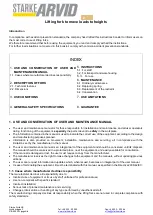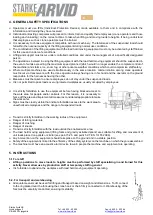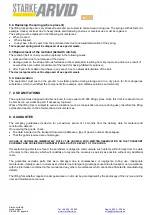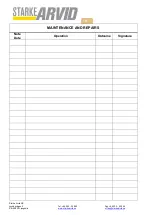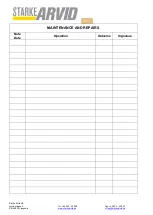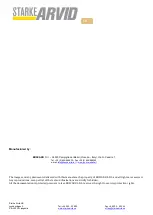
Starke Arvid AB
Lyckåsvägen 3 Tel: +46 522 - 22 000 Fax: +46 522 - 22 344
SE-459 30 Ljungskile
5
3. USE CONDITIONS
It is necessary to conduct a visual control and general daily control before starting any type of work.
Do not use the fork before having clearly understood the indications in this manual.
Check the material to move meets the following requirements:
•
Variable dimensions within the field of opening and length of the points.
•
The weight of the goods must fall within the capacity indicated on the plate applied to the fork.
•
The maximum height must fall within the measurements indicated in the tables above.
•
The depth of the pallet or similar must not exceed 100 cm (unless forks are designed and manufactured on requested
specifications).
•
The maximum length of the pallet or similar must not exceed 20% of the external opening of the two points. Example
of fork regulated to 100 cm external point, maximum width allowed for pack 120 cm.
•
The material placed on the pallet or similar must guarantee even distribution of the load above the fork points.
•
when using a fork lift in a worksite, make sure the protection net is in position.
Operating method:
Unit loads
The
lifting forks
were designed and manufactured to move and lift any unit material placed on a pallet or similar to
heights, according to the requirements indicated in points 3.8 and 5.2.5 EN 13155:2009;
The pallets used to move materials to heights (
re-usable customised wooden pallets
) must meet the requirements
indicated in the definitions of Standard EN ISO 445:2009;
The re-usable customised wooden pallets must be marked;
The loads on the pallets to be moved to a height must be identified as a
unit load
(point 5.2.5.5 EN 13155:2009);
The unit load on the pallet must be wrapped in plastic (thermo-retractable film) and supported with crossed supports.
The support materials must meet UNI reference standards. The load must be certified by the manufacturer.
Before forking the load, the operator verifies the
unit load
is not damaged;
Having forked the load secure it with the lifting fork, using the
hold device
(band or chain), to avoid it sliding during the
lifting phase.
Proceed to lifting. The authorised employees must conduct the various movements according to the information and
training received, and/or in relation to their experience matured over their working lives.
Non-unit loads
The
lifting forks
were designed and manufactured to move and lift any unit material placed on a pallet or similar to
heights, according to the requirements indicated in points 3.8 and 5.2.5 EN 13155:2009;
A non-unit load is loose material placed on a pallet or material on a pallet without plastic wrapping and/or crossed
supports or plastic or deteriorated supports. A non-unit load is also material wrapped in plastic and supported, placed
on a disposable pallet (Standard EN ISO 445:2009);
To lift non-unit loads, systems must be exclusively used that prevent all and/or part of the load falling. In this case the
lifting fork, compliant with Standard EN 13155:2009, should be used combined with the secondary positive hold device
or rather a metal bin manufactured by us or the load protective net provided by us.
Proceed to lifting. The authorised employees must conduct the various movements according to the information and
training received, and/or in relation to their experience matured over their working lives.
To use secondary positive hold devices, consult the relevant user and maintenance manuals.
It is strictly forbidden to use the lifting fork to lift loose materials to heights or using methods other than those
indicated.


